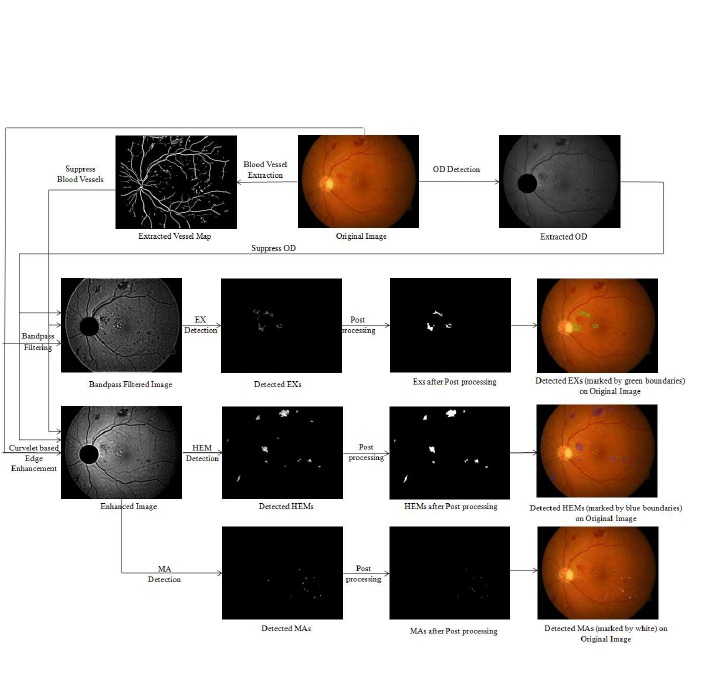- ALL COMPUTER, ELECTRONICS AND MECHANICAL COURSES AVAILABLE…. PROJECT GUIDANCE SINCE 2004. FOR FURTHER DETAILS CALL 9443117328


Projects > ELECTRONICS > 2017 > IEEE > DIGITAL IMAGE PROCESSING
Diabetic Retinopathy (DR) is characterized by the progressive deterioration of retina with the appearance of different types of lesions that include microaneurysms, hemorrhages, exudates etc. Detection of these lesions plays significant role for early diagnosis of DR. To this aim, this paper proposes a novel and automated lesion detection scheme which consists of the four main steps: vessel extraction and optic disc removal, pre-processing, candidate lesion detection and post-processing. The optic disc and the blood vessels are suppressed first to facilitate further processing. Curvelet based edge enhancement is done to separate out the dark lesions from the poorly illuminated retinal background while the contrast between the bright lesions and the background is enhanced through an optimally designed wideband bandpass filter. The mutual information of the maximum matched filter response and the maximum Laplacian of Gaussian response are then jointly maximized. Differential Evolution algorithm is used to determine the optimal values for the parameters of the fuzzy functions that determine the thresholds of segmenting the candidate regions. Morphology based post-processing is finally applied to exclude the falsely detected candidate pixels.
Support Vector Machine (SVM), Gaussian Mixture Model, Ant Colony Optimization Algorithm.
This paper proposes a novel and automated lesion detection scheme which consists of the four main steps: vessel extraction and optic disc removal, pre-processing, candidate lesion detection and post-processing. A simple yet effective integrated scheme for lesion detection is suggested that includes different pre-processing techniques, coupled with MF and LoG filter followed by post-processing operations. These techniques when combined in a sequential and an intelligent manner, offer a very much effective and efficient scheme to detect the different lesions irrespective of their texture, shape, size etc. Curvelet transform is a very good candidate for dark lesion enhancement. The optimally designed BPF is well-suited for bright lesion enhancement. The gain and the cut-off frequencies of the BPF are obtained automatically through MSSIM maximization. The optimal fuzzy parameters and the threshold values obtained through MI maximization of MFRmax and LoGRmax offer a soft detection that improve the overall lesion detection performance. The automatic selection of the fuzzy parameters determines the thresholds of segmenting the candidate regions that enhances the system robustness to handle diverse types of images irrespective of quality and inherent properties. Morphology based post-processing is finally applied to exclude the falsely detected candidate pixels.
BLOCK DIAGRAM
